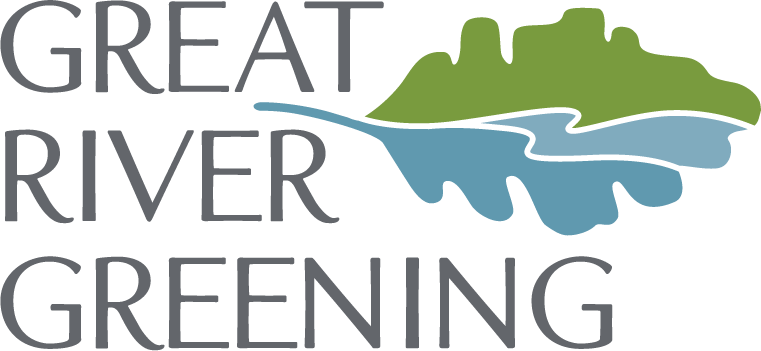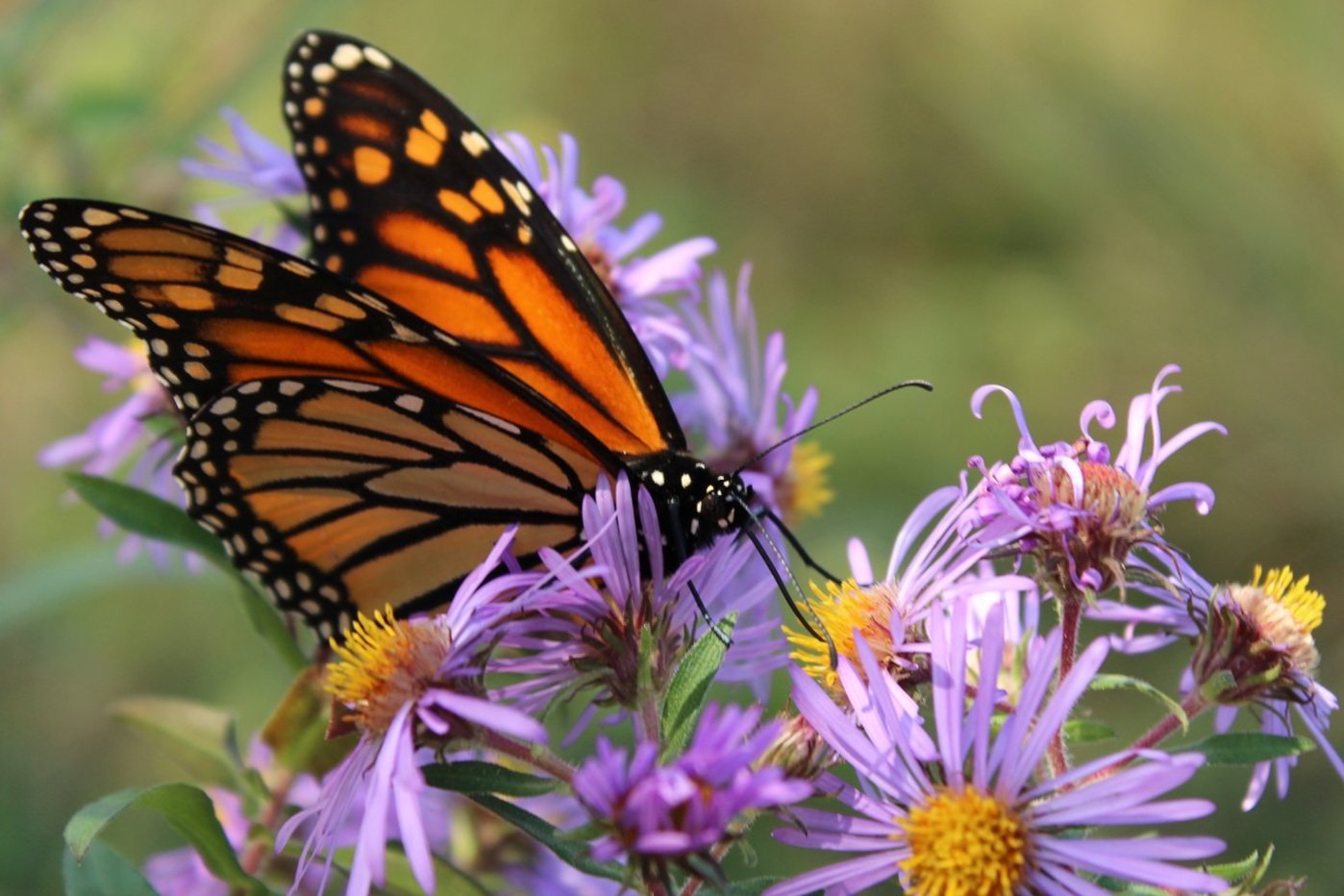Reflections on 2023 and Jumping into 2024
01/22/2024
“Great River Greening’s impact has grown tremendously in the past year, from number of acres restored, number of wildflowers and grasses planted, and number of unique project sites and partners who are asking for our support.
But the most impressive to me is the number of individuals from communities throughout Minnesota who have stepped up and said I want to be a part of this. I want to protect Minnesota’s climate future—whether that’s for the good of the state, our green spaces, or for our kids or the next generation. That fills me with hope and propels GRG take action and make a big impact.”
Kateri Routh, Executive Director
In 2023, our team of ecologists and naturalists worked on a record-breaking 200 restoration sites, creating more climate-resilient habitats, restoring more prairies and grasslands, and transforming more forests and wetlands than ever before. But we didn’t do this alone. We can’t thank our volunteers, donors, and supporters enough for the enthusiastic commitment to this essential work. Please join us in celebrating these highlights:
VISION FOR 2030
Launched in January 2023, GRG has a bold plan to mitigate the effects of climate change in Minnesota and protect our shared natural systems and habitats. Our Vision for 2030 is healthy, climate change resilient ecosystems throughout Minnesota. Recognizing the need to address our climate future in this decade and the desire of Minnesotans to address climate change through nature, GRG will leverage the expertise of our ecologists and naturalists to restore Minnesota’s habitats to health and resilience.
COOL SAINT PAUL
This pilot tree canopy program, launched in January 2023 in partnership with the Saint Paul Public School District and Saint Paul residents, takes aim at mitigating the devastating effects of urban heat islands that disproportionately affect low-income areas and communities of color. GRG collaborated with a consultant specializing in racial, health, and environmental equity to kickstart this initiative, where community-based input laid the groundwork for planting 170 trees (and counting).
“Lack of tree canopy is an equity, public health, and environmental issue. This is really important because our tree canopy and trees in our community provide benefits for the health of everyone within a community: from the air we breathe, to the shade we seek, and so much more”
Kateri Routh, Executive Director
USDA’S FOREST SERVICE AWARDED A $10M GRANT TO GRG…
… to combat extreme heat, enhance climate change resilience, and increase equitable access to tree canopies across Minnesota. Our award stands out as one of the highest funded programs in the nation that brings together 15 partners to plant and water nearly 14,000 trees in key Minnesota urban and community heat islands over the next five years. These community-based efforts will improve the likelihood that the trees planted now will mature into a protective, resilient tree canopy, improving health and economic vitality for Minnesota’s future.
FUTURE STEWARDS
Due to a successful launch in 2022, we expanded our youth environmental education program in 2023. Our naturalist provided hands-on planting, restoration, and environmental stewardship experiences for over 600 students (grades 3-10) in partnership with three schools in Minneapolis and the East Metro.
“When students have an active role in planning, designing, planting, and maintaining a native garden, they are better able to understand the importance of supporting healthy habitats in Minnesota.”
Jessica Drummond, Naturalist & Outreach Coordinator
BRIDGING AGRICULTURAL AND NATURAL SYSTEMS
Our work supports thriving economic and environmental outcomes through entrepreneurship, by promoting regenerative agriculture practices such as silvopasture (grazing animals in woodlands and savannas), planting cover crops, and planting perennial grains. Historically neglected wooded areas and croplands are now being managed through grazing and Continuous Living Cover (CLC) to provide habitat for birds, pollinators, and other wildlife.
OUR COLLABORATION WITH AGRICULTURAL COMMUNITIES…
… helps us improve water quality in Minnesota’s largest river corridors: the Mississippi and Minnesota Rivers. Our incredible team of ecologists and regenerative agriculture specialists is working (through education, consultation, and technical assistance) with the community across Nicollet County. Momentum is growing, and we have seen increased awareness of and support for additional CLC crop rotations. Through direct conversations with farmers, GRG supported the planting of 4,400 new acres of CLC in Nicollet County, improving soil health, water quality, and carbon capture.
“There are so many opportunities here. People are ready to make some changes and doing regenerative agriculture here really makes perfect sense… It brings the community together. We’re all trying to do the same thing.”
Kristy Cowdin, Ecologist & Conservation Specialist
LAND RESTORATION WORK
While we add new programs and initiatives, we have not waivered in our commitment to restoring habitats to health. This year, we created resilient habitats and addressed biodiversity loss through management and adaptive planting on over 5,000 acres. Through 2024, we are expanding our Pollinator Central Corridor project to add 800 acres of new pollinator habitat throughout central Minnesota, a habitat that is in decline and is essential for pollinators.
LOOKING AHEAD
Our land-based restoration—work we’ve been doing for nearly 30 years—will center on three measurable impacts in 2024 and beyond:
Enhance, restore, or otherwise facilitate the creation of resilient habitats on over 5,000 across over 200 sites annually.
On half of that acreage, increase the biodiversity potential of those habitats by at least 50% through planting native plants and/or the removal of invasive species.
Sequester more than 100,000 tons of carbon annually.
As a result, over 1,300,000 Minnesotans will have access to resilient green spaces restored and enhanced by our ecologists and volunteers. You can be a part of this critical work in 2024 and beyond. Join us in whatever way makes sense to you:
PARTNER WITH US. Reach your company’s ESG and sustainability goals by partnering with Great River Greening. We can create opportunities that make sense for you based on your company’s priorities.
SUPPORT THIS WORK. Your partnership in this stewardship will directly improve water quality, air quality, natural areas, and wildlife for all Minnesotans.
VOLUNTEER. We have a variety of year-round opportunities for volunteers to get connected to nature. Yes, even in winter! Check our calendar anytime for a current list of event opportunities.
Photo Credits: Forest and prairie border with blue sky and clouds (Bruce Nimmer); students planting trees in Saint Paul on Arbor Day 2023 (Brennan Blue); Looking up at a forest canopy and blue sky (Phil Davies); GRG naturalist plants a pollinator garden with Future Stewards students (Brennan Blue); Four people standing in a Kernza field at sunset (Brad Gordon); Bridge over Seven Mile Creek (Julie Baumeister); Monarch butterfly on purple aster (GRG); Potted native shrubs ready to be planted (Bill Lee).








